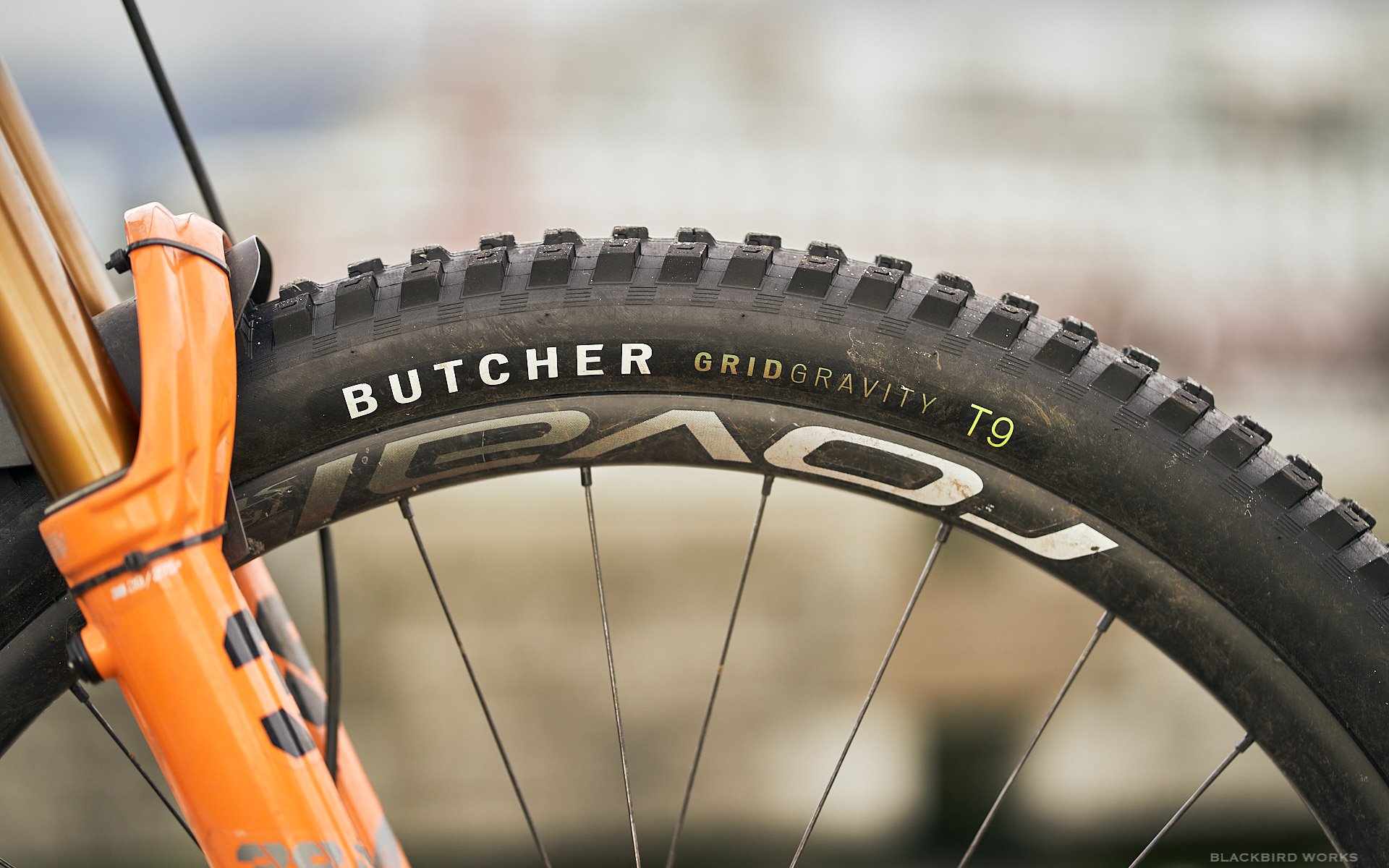
REVIEW
Specialized Butcher T9 Tires
Patience has a way of paying off.
Isn't that what we're always being told by our parents, partners, and mindfulness apps? In bikes as in life, nothing good ever comes easy.
In the fall of 2020, Specialized released a new line of tires. Well, not entirely new. The tread patterns were familiar, but the rubber compounds were all new, and that's a big deal because, historically, Specialized tires enjoyed a generally good reputation for performance, made even better when you consider the value proposition - but the Butcher had lagged somewhat recently (whereas Specialized XC and trail tires have a lot of fans). Whether someone thinks they were merely decent, good, or even great depends a lot on When that person's opinion was formed. That's because despite being a very large bicycle company (that, ironically, was founded by Mike Sinyard as a way to import European road tires into the US) Specialized relied in the past on other suppliers to manufacture their tires for them. If that is news to you, know this: there are not that many manufacturers of bicycle tires in the world. Far fewer than there are bicycle tire brands.

Making rubber mixing look fun. Photo: Specialized.
So, despite the fact that Specialized manufactures a whole lot of bikes every year (thus creating a large OE purchasing pool for tires of all kinds), and has devoted a significant amount of R&D time over the years into tire development, they still relied on outside production. This has its upsides and downsides, not the least of which is that it meant they were relying on a competitor to manufacture their product for them*, most recently CST (Cheng Shin Tire, the owner of the Maxxis brand). Thus, over the years, Specialized tire quality varied - and of course this could be different depending on whether you meant XC, All Mountain, DH, road, etc...that's a lot of different tire categories and some were better than others.
*this happens in the world of sports equipment more often than most of us realize.
Specialized realized they had a problem, or at least a non-optimal situation, so four years ago they teamed up with IRC Tire, and together they built a factory in Vietnam. Specialized engineers had always developed their own tread designs and constructions, so they didn't need help there, but historically they had relied upon their supplier (ie. their tire manufacturing partner) for help with their rubber engineering. Again, when you put something like that in the hands of your competitor, you may not have access to their best compounds, or at least not right away, or your pricing or delivery windows may make it hard to be competitive. This new partnership with IRC meant Specialized could bring production as close to in-house as possible without taking on the financial burden of building and running a factory on their own.
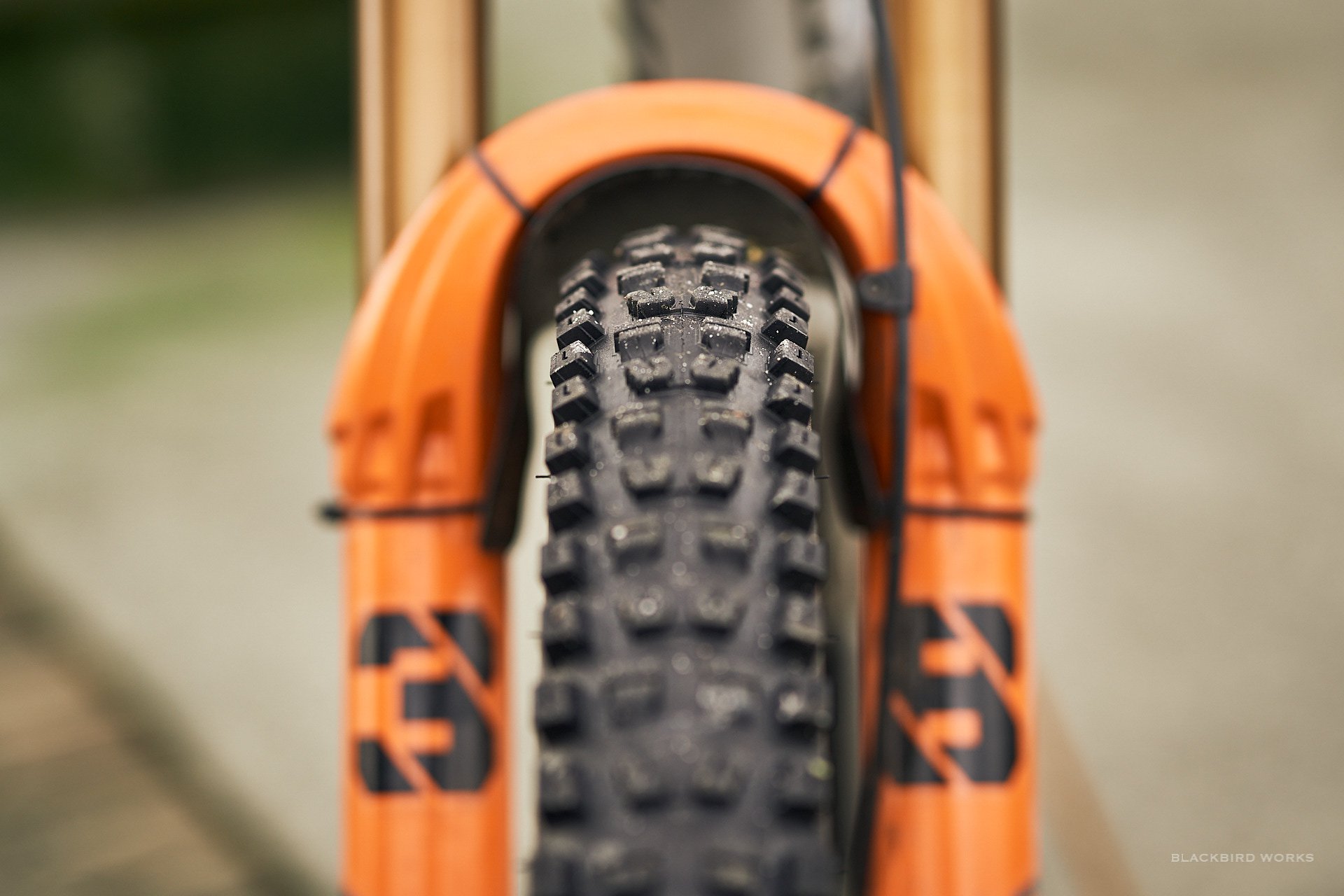
Specialized Butcher T9 in a 29 x 2.6 is not a low-volume tire.
The big story is the new rubber compounds, called GRIPTON, and Specialized has kept the nomenclature simple: 'T' simply stands for 'tread', and the number that follows - using a scale of 1 to 10 - indicates the compound's characteristics: a lower T number means the compound will have a higher rebound rating, whereas a higher T number means the compound will have a lower rebound rating, less elasticity and more damping.
For the sake of this discussion, there are three tire treads you might want to know about:
- Eliminator, which is a less aggressive, all-around tread that'll roll faster than the other two listed here (used as a rear tire on bikes like the new Stumpjumper EVO),
- Butcher, the tire tested here, and by far the most commonly spec'd and used Specialized tire for aggressive trail and gravity riding (spec'd front and back on the Enduro as well as Demo with DH casing),
- and Hillbilly, an intermediate to soft conditions tire that looks like it would eat loam for three square meals a day but may struggle on slabs (we'll have to test this out to be sure)
To reduce confusion I'm going to list the tire models and specs available in the new rubber below. Specialized's site still lists the older models of these tires - to be sure you're looking at the new rubber, you want to look for T7 or T9 in the tire's name:
ELIMINATOR | GRID GRAVITY | 2BR | T7/T9 TIRE | 650B x 2.3 or 2.6
ELIMINATOR | GRID GRAVITY | 2BR | T7/T9 TIRE | 29 x 2.3 or 2.6
BUTCHER | GRID TRAIL | 2BR | T9 TIRE | 29 x 2.3 or 2.6
BUTCHER | GRID GRAVITY | 2BR | T9 TIRE | 650B x 2.3 or 2.6
BUTCHER | GRID GRAVITY | 2BR | T9 TIRE | 29 x 2.6 - Tested as front tire
BUTCHER | GRID GRAVITY | 2BR | T9 TIRE | 29 x 2.3 - Tested as rear tire
HILLBILLY | GRID GRAVITY | 2BR | T9 TIRE | 650B x 2.3
HILLBILLY | GRID GRAVITY | 2BR | T9 TIRE | 29 x 2.3
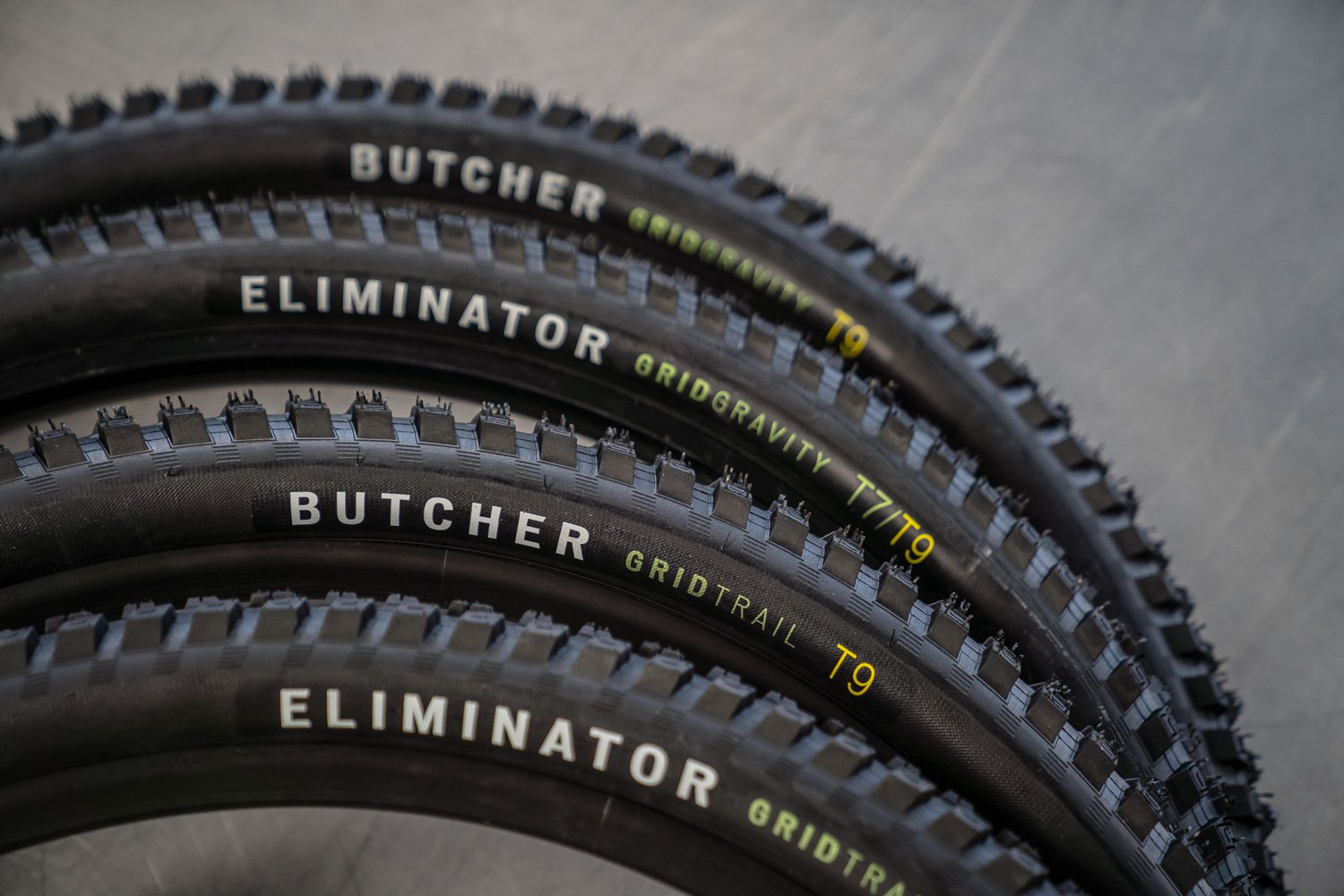
Specialized released their new T9 compound in the Butcher and Hillbilly, and the Eliminator comes in a T7/T9 blend that lends itself to use as a rear tire - or faster rolling uses. Photo courtesy of Specialized.
The tires arrived just as the days got short, wet, and nasty in November. With the choice between Grid Trail or Grid Gravity casing on my Enduro test bike, I opted for Grid Gravity on the front and back. Our slippery winter conditions mean we want to be running lower pressures than normal to eke out more traction. Side bet: I'd rather push a bit more weight in the winter than suffer the misery of attending to a flat in near-zero conditions. Ironic note: the tires mounted up easily and I haven't suffered any flats, but the stock Specialized tubeless valves have a shape that doesn't always provide a good seal on the rim bed, and one resultant late start had me buying beers for that day's posse, which numbered 6.
Grid Trail is a newer casing from Specialized, that replaced the old Grid. It is a 1.5-layer construction, with bead to bead coverage in the second layer. I can confirm that Grid Trail is more supportive and offers better flat protection (pinch and poke) than Grid, as I never suffered a flat despite abusing them for the better part of a year.
Grid Gravity casing is a 60 tpi double overlap construction that has a folding bead but is essentially a DH-rated tire (Specialized has eliminated their Black Diamond DH casing). I'd compare it to DoubleDown in terms of support and feel, rather than a full DH casing from Maxxis, with the weight to put it squarely in that range.
Here's how the claimed weights stack up for 2.3 & 2.6 sized Butcher T9s in Grid Trail vs. Grid Gravity casings:
Specialized Butcher T9 Grid Trail
- 29 x 2.3" approx. 975g
- 29 x 2.6" approx. 1050g
Specialized Butcher T9 Grid Gravity
- 650B x 2.3" approx. 1240g
- 650B x 2.6" approx. 1250g
- 29 x 2.3" approx. 1290g
- 29 x 2.6" approx. 1315g
There's a substantial weight penalty to the burlier casing, and I will put a Grid Trail-equipped wheelset on the bike as temps warm up a bit and revisit this review with updated comparisons. But for now, Grid Gravity it is, 29 x 2.6 front and 2.3 in the back. I mounted them onto the Roval wheels that came with the bike but it's worth noting that previous to this test, I had been running Maxxis Assegai 29 x 2.5 MaxxGrip up front and a DHR II 29 x 2.4 MaxxTerra out back as well as CushCore Pro at both ends, so this setup was lighter than what I'd been lugging around. No one will be surprised to hear that both grip and damped feel were off the charts with that portly combo. In fact, I'll save more of this for the review but that combination in conjunction with a coil shock on the Enduro was the gooiest setup I've ever run, hands down. I was only starting to explore new levels of confidence and knocking off lines that I'd had issues with forever before I made the switch. On one hand, I was a bit apprehensive about giving up any performance advantage at all - especially with the others I ride with making constant strides these days. However, sacrifices must be made and Specialized sounded pretty pumped about these new tires, so on they went.
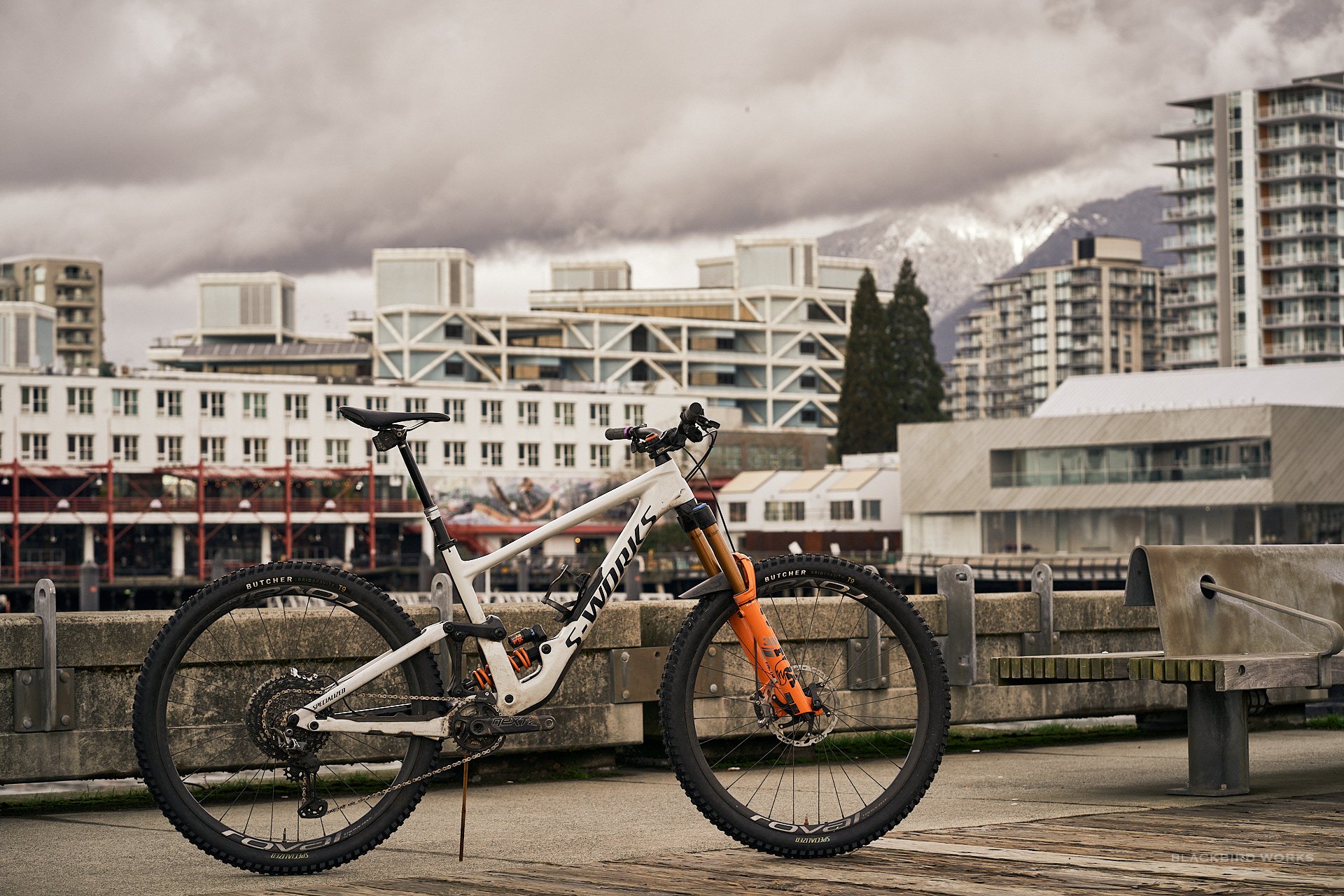
If you're lucky enough to get your hands on a Specialized Enduro (rare enough even before Covid), you'll be happy to know the stock Butcher tires will have the new T9 rubber compound - it's a pretty big upgrade.
Riding the Butcher Grid Gravity T9
I needn't have worried. On my first ride I ran my pressures a bit higher than needed - 19 psi front, 21 out back. It was a cold, wet day when I'd normally air down a bit, but I was coming off a CushCore setup (15 front, 17 out back for steep and slippery conditions where traction is everything) and wanted to ease my way back into soft settings. I confess to expecting a bit of a downgrade in grip, but that's partly due to the old Butchers, which were quite good in firm, loose over hard, and dry conditions, but suffered mightily in the wet, especially as it got colder. I expected an improvement with the new rubber, but by the end of the first ride the only thing I was left wondering was whether I'd given anything up in confidence at all.
After a few more rides, my familiarization increased, I narrowed my pressure ranges, and started to get better acquainted with the beastly T9 Butchers. Once the rain starts in October and November, it doesn't seem to stop. Just when you think you've got the measure of slimy roots, the snow line dips, and now you're playing with slush, mud, and snow in the upper trails. If your tires suck, you might as well be riding a gravel bike with square wheels and v-brakes. Fortunately, I was in a happy place with the new Butchers. Giving them no shortage of opportunities to scare me or let my confidence falter, they proved to be consistent performers. Wet, non-perpendicular roots? Got it. Steep, sketchy slab lines? Place the front tire and watch it trace a perfect line. Get a little too zesty and need some green N driver panic braking? Yer covered.
The defining moment came when I was least expecting it. Not at my best, I was managing my way down pretty well and cleaning some lines that are usually 80/20s for me - ones I'll get on most good days but still can stick in the back of my mind on a bad day and cause a balk. But then we came into a section that is a 10/90 for me - I can clean each section individually, but there are one or two cruxes that can throw me off (it's a long sequence of moves). The first is a very off-camber, smooth rock that is slick when wet. To clean it you either have to carry a little more speed than you'd like for the next section and hit it straight, or you can slow down and execute a 'smear and slide', hit the catch at the bottom, adjust and proceed. Usually I try the latter, but on this day I hit it straight and, as is too often the case, made it through with way less drama than I expected. What greets you next are a series of awkward, slow speed ka-chunks with some direction changes, tree-dodging, and twisty roots. All perfectly gettable if you manage speed and line and just gut it out - which I did. That leads you into another off-camber section into an up-and-over with a knuckle-buster tree on one side and exposure on the other. The move itself is simple but it's easy to lose your nerve - or the skin on the outside of your hand. Having not put a single knob out of line, I simply rode the whole thing and, without really paying much conscious energy to it - nailed it. Smoothly. And just like that, I realized that if I was standing in a bike shop looking at an Assegai at $130 and a Butcher T9 at $100 CAD, I might just take the option that costs $30 less. After all, it's a guarantee I'll have to buy the beers again at some point. They don't call it Roggey-time for nothing.
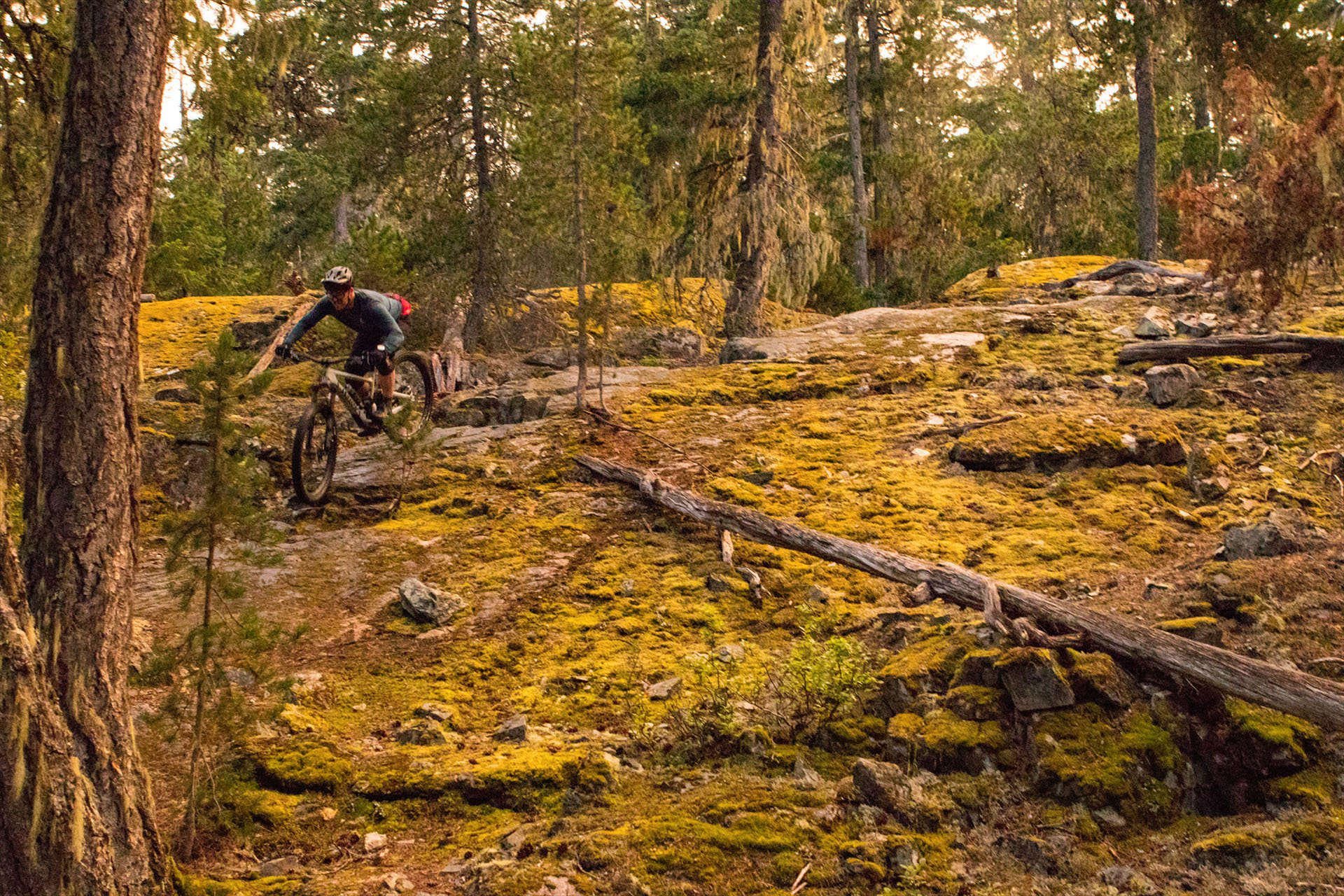
Testing of the Butcher T9s was generally in wetter, nastier conditions that this, but look at those colours!
Overall impressions
The previous gen Butcher was a good all-around tire for aggressive trail riding, but not a great one. The center knobs alternate between blocky, brake-friendly square units and generously-ramped directional knobs. I had no complaints about their ability to drop anchor at a moment's notice and help you hold a line, even in rough, scattery lines where you're fighting to stay planted. Despite this, they also roll quite well - comparable to a DHF/DHR II combo. And durability was admirable: on the North Shore's predominantly soft conditions, we can get more life than normal out of a rear tire, but I did my share of pedaling up paved roads (especially during the first 3 months of Covid) on those Butchers and they gave me most of a year of use at an average of two rides per week.
In firm corners is where things sometimes got a bit hairy. While I found them to be pretty good in loose over hard conditions - something we generally see in summer only - they had a tendency to break loose unexpectedly under hard pressure in firm conditions, and when that happened I didn't know when I'd regain traction. This popped up as speed increased in unsupported corners, which is exactly when you need things to be predictable. In softer dirt, it wasn't an issue and the Grid Trail casings were still quite supportive, but those squirmy knobs were alarming. This is despite a change that happened in the last few years to shrink the gap between the center and side knobs in order to create a more predictable transitional moment between the two as you lean over. I don't think they quite nailed it, but I haven't had a chance to ride these new Butcher T9s in warmer, drier conditions just yet. Soon enough, I hope.
At slower speeds the corner knobs definitely do their job up to a point, but then the rubber would let them down. That is where the T9 rubber outshines its predecessor and I've enjoyed the grip of those side knobs immensely. Generous siping in all the knobs is likely working harder with the new rubber, too. The old Butchers weren't bad in the wet, but they weren't as good as some other options I've enjoyed from Maxxis, WTB, and when the skies darkened I always knew I'd be a little more on edge. With the switch to T9, I'd put them up against all of the aforementioned and rank them at least on par - rain is no longer an arbiter of noticeably reduced grip.
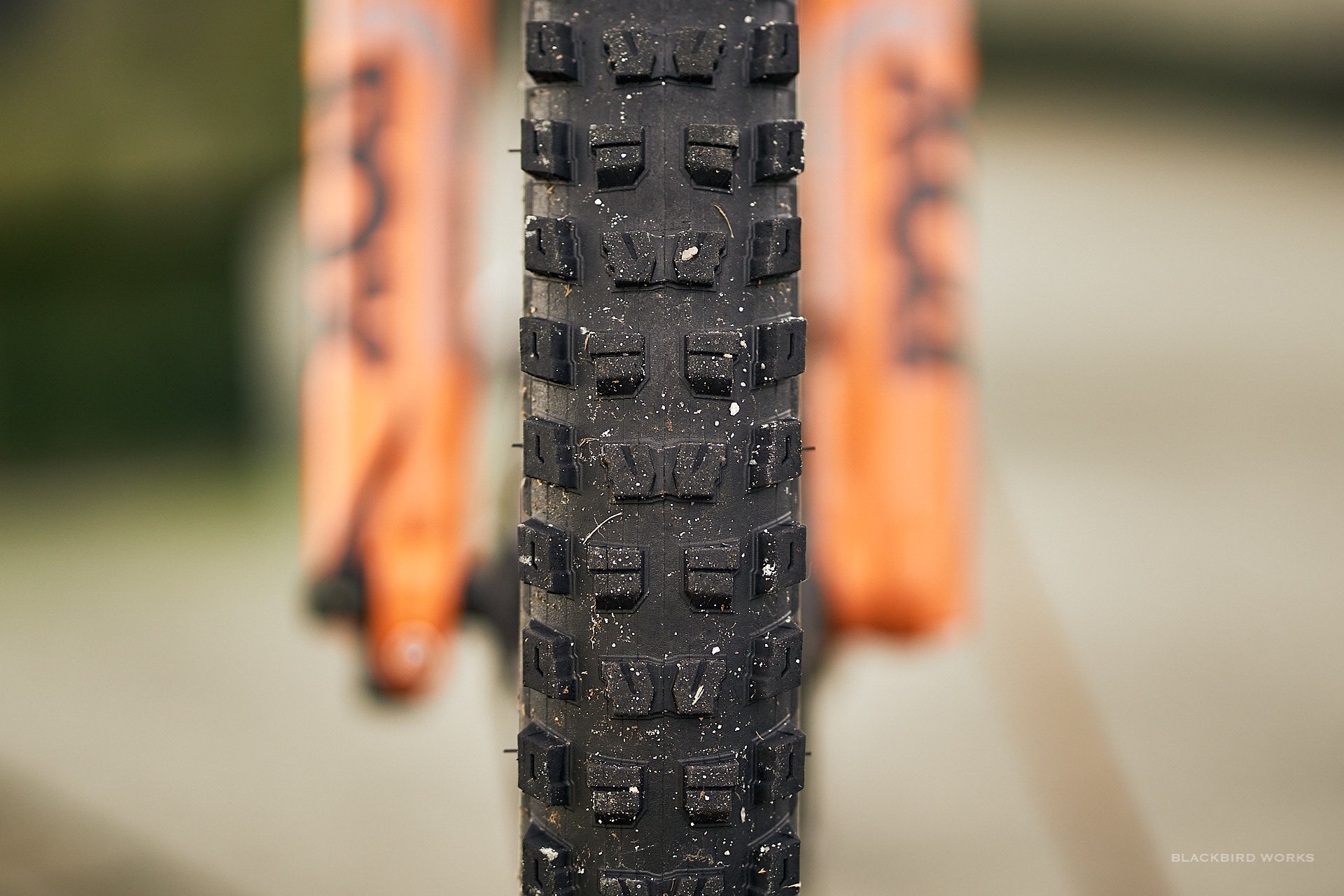
Discussing Tire Design Theory with Specialized
I have used a lot of words to talk about these tires so far, and I'm sure there are tire nerds among you that would like to go deeper. Spending some time on the Grid Trail version of the Butcher T9s will allow for more comparison and balance, because to be honest, not everyone wants to push nearly 2,600 grams of rubber around (me included, unless I have to). But I spent a bit of time on a zoom call with Matt Bialick, Specialized's US-based tire PM, and Wolf VormWalde, who's had a lot of responsibility for Specialized tires (road, MTB, etc) for at least 10 years now (having also spent time at Continental). It would be a waste not to share a few of the things I learned:
The new rubber compounds - and specifically T9 - were developed at the request of the Specialized Enduro team, who weren't happy with previous tire options. Before T9 came along, there was T7, which uses a silica-based compound that attracts water so it can then break through the wet layer to create grip. Some of the learnings that led to T7 came from road and gravel research, but T7 wasn't good enough for the enduro team, so they had to dig a little deeper. T7 was at the limit of polymer blends using silica, so they changed to carbon black, which is used in motorsport performance tires, and composed of stirene butadiene, which has a high oil content and an extremely slow rebound value. It's the same polymer that Maxxis and Michelin use, but with different amounts of oil and carbon blacks.
Wolf was candid about Specialized's rubber compound performance envelope. Their goal was to come up with something that provides a high amount of dampening across a wide temperature array. What they settled on was optimized around 20º C (15 - 25 degrees being the best range of temps) and that it probably wasn't as good at high temps as some others. Here he specifically named Michelin's tire designs as being good in high energy environments (ie. high speeds or high temps) and I thought it was notable that he was willing to concede that 'S' rubber wasn't as good at higher temps. He also mentioned that Specialized T9 tires have a 50 durometer rating across the tire, whereas Maxxis, as many of you know, varies durometer and a 3C compound tire has a softer durometer of 45 at the edges and a harder durometer in the middle. Different ways to skin a tire.
Temperature is an interesting topic here - Deniz has been digging into that a bit and we'll be talking about how temperature affects tire performance more in the future. I'd love to spend more time chatting with Wolf about truly nerdy tire tech (we'll try to make this happen) but I wanted to share his use of the term Hysteresis, which is fundamental to the formula that determines a mountain bike tire's grip. Broadly, it means the dependence of the state of a system on its history. I'm going to need about four semesters of engineering study to really grasp it, but it can affect magnets, shape memory alloys, and also occurs in the deformation of rubber bands, which is a lot closer to today's subject matter than those other two. I'm going to have to dig into that into more detail later, but I thought it was useful to hear that it's a key component in Wolf (and Specialized's) rubber compound engineering theory. And so far, based on limited experience, it's paid off.
Specialized Butcher Grid Gravity 2Bliss T9 can be found online for $70 USD - here's the 29in x 2.3 or 2.6 & here's the 27.5 x 2.3 or 2.6
Specialized Butcher Grid Trail 2Bliss T9 has a retail of $60 USD - here's the 29in x 2.3 or 2.6 & here's the 27.5 x 2.3 or 2.6
They can be found online in Canada as well, you just have to hunt around a little bit. Canadian SRP is $100 CAD for Butcher Grid Gravity and $95 for the Grid Trail casing. More info at the Specialized website.
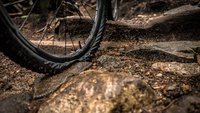

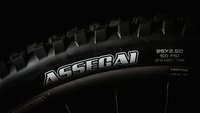
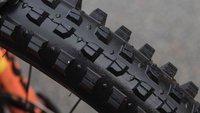

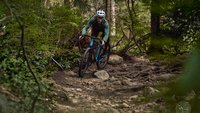
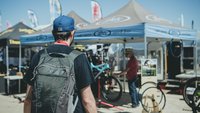


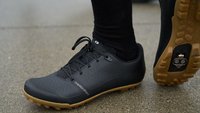
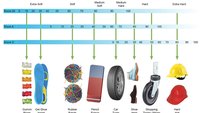
Comments
boomforeal
3 years, 1 month ago
i appreciate the vivid ride narrative (i haven't ridden the shore for over 18 months so have to make do with living vicariously through these kinds of stories -- and you have a great voice for this pete) and the insights into specialized's new rubber (i ran a previous gen butcher for a bit last year and was surprised by how 'dead' it felt -- glad to know it wasn't all in my head) and tire manufacturing setup
but i can't help notice there's not much here on how the tire rides or its non-compound characteristics. are we assumed to be so familiar with the butcher [or the dhf ;-)] at this point that a review of the tire doesn't need to address how it handles in corners/various angles or under heavy braking, what the tread/lugs/ramping/siping is like and translate to trail manners, etc.? not all of us tire nerds are compound jockeys -- some of us enjoy a good tread pattern analysis
perhaps i'm jumping the gun and this will be addressed in the promised update -- on that note, i really appreciate that nsmb is taking a long term approach to reviewing stuff where it is feasible and makes sense
Reply
Pete Roggeman
3 years, 1 month ago
Hi Omar - long time no hear from! Hope you're doing well. Thanks for the feedback - I've updated the review with some chewier ride impressions that I hope should address your comment. Give it a look and let me know if that helped.
Reply
boomforeal
3 years, 1 month ago
ooh yeah, that's the good stuff
at the risk of going full tire nerd and leaning into confirmation bias, your impressions make a lot of sense
i found the previous butcher grids to brake well in a straight line and wear slowly (glad those two characteristics remain) and corner really well in most conditions, but get sketchy when things get especially wet or dry. it sounds like the new rubber has solved the former issue; as for the latter...
there's an interesting primer on mtb tires on blister that talks about the impact of transition knobs. if the butcher was redesigned so that there's less of a gap between the inner and side knobs, that might explain why they don't dig in well when leaned over in hard conditions
thanks for indulging me pete ;-)
Reply
boomforeal
3 years, 1 month ago
This comment has been removed.
JT
3 years, 1 month ago
That temp thing is a REAL interesting bit. I've thought about it before, but mostly at or below the freezing point for the frozen days on the fat bike. You know, those days when your brakes feel like your applying blocks of wood to your rotors. I hadn't considered what warmer temps do to tire performance outside of motor racing. Color me intrigued for the follow up.
Reply
Pete Roggeman
3 years, 1 month ago
Climbers usually get better traction when it's cold out and that's had me thinking for a while now about this. Deniz independently started testing tire durometers at different temps but that's only one part of the equation...it's not a simple equation but we are certainly keen to learn more.
Reply
slyfink
3 years, 1 month ago
Thanks for the review. Could you provide a bit more information on carcass construction in Grid Trail vs Grid Gravity? (is Grid Gravity a full-blown DH construction? - low TPI, triple layer, reinforced sidewall? or more like DD and SG?
Reply
Pete Roggeman
3 years, 1 month ago
Added (but for quick ref, Grid Gravity is dual-ply 60 tpi and yes, reinforced sidewalls - good comp to DD).
Reply
Tjaard Breeuwer
1 year, 6 months ago
And noticably beefier than the previous BLK DMND (I want to buy a vowel please).
Reply
WalrusRider
3 years, 1 month ago
I was lucky enough to snag one of the new Stumpjumper Evos which came with Specialized's new tires. I'm definitely a tire nerd and have tried numerous brands and models of tire over the last few years. Most recently I've been riding e13 LG1r Mopo and Plus and really like this tire setup year-round. Despite loving the e13s I decided to give the Specialized tires a chance and I'm thoroughly impressed. Traction is excellent in all conditions including nasty wet winter trails. The casing is noticeably lighter than the LG1rs but so far no flats. I like the more damped feeling of the LG1r casing better but it's not a deal breaker for me with the Trail casing on the Specialized tires. I may go with the Gravity casing if I decide to stick with these Specialized tires. So far, no regrets and I think the new Specialized tires are a solid choice and much better than the last generation.
Reply
Allen Lloyd
3 years, 1 month ago
This summer I tore a Conti and needed a tire fast. My LBS had a pile of Specilized tires and I grabbed the 29X2.6 round profile I think it is called a Ground Control. I was amazed at how much grip it has compared to how fast it rolls. As a rear tire it is a great compliment to a Conti Trail King up front. It breaks away earlier so the bike will over steer ad it is very predictable. I live in Montana so dry with sharp rocks, your experience may be different.
Reply
Pete Roggeman
3 years, 1 month ago
I haven't ridden the Ground Control but I know that for riders in suitable trail conditions for that tire, it has always been well-loved.
Reply
mrbrett
3 years, 1 month ago
You had me at hysteresis.
Reply
Velocipedestrian
3 years, 1 month ago
This. The only time I've heard the term previously is in relation to damper oil getting foamy with air. I'd thought it was specific to that mix, but makes sense that it's the recent history of use.
Reply
mrbrett
3 years, 1 month ago
I've busted it out in scrabble before.
Reply
Pete Roggeman
3 years, 1 month ago
How'd you get hysteresis to work in scrabble!? Nice work.
Reply
Jerry Willows
3 years, 1 month ago
Great review Pete! I've got a T9 Trail coming for my Enduro but have been on the stock Grid ones since November with no flats and amazed how well they roll, wear and grip. I've had Maxxis tires ready to put on but didn't feel the need to.
Reply
Pete Roggeman
3 years, 1 month ago
Definitely will be interested to hear what you think of T9. Have you been running Assegai out back as well?
Reply
Jerry Willows
3 years, 1 month ago
just the stock grid butchers F and R. No flats, great wear rate and rolling resistance. $130 for a rear tire with maxxgrip is just silly.
Reply
Kelownarider
3 years, 1 month ago
My issue with previous gen Butcher was flats. I had two of them over the past few years, both sliced within a handful of rides. Maybe just unlucky?
Reply
Pete Roggeman
3 years, 1 month ago
We don't have a lot of slicey rock on the shore, but there's lots of ways to flat and I found the 2020-gen Butcher in Grid Trail to be fine (no flats). I realize I went up to Grid Gravity for this test and that's an apples to very big apples comparison, but no issues once again (unsurprisingly).
Reply
Johannes Schmidt
2 years, 4 months ago
Sliced both a Grid Trail and Blck Dmnd in record time, and als flatted (snakebites) the Grid Trail 3-4 times in a few weeks although I ran them with Nukeproof ARD.
I really liked the hard wearing compound and their feel on trail, but I haven´t flatted Magic Mary Super Gravitys for 4 years straight before with the same setup.
Reply
fartymarty
3 years, 1 month ago
Pete - have you ridden the Verdict / Judge combo? If so how do these compare?
Reply
Pete Roggeman
3 years, 1 month ago
WTB Verdict & Judge is a terrific combo - Cam wrote a great review about it here.
The only front tire I've ever had that inspires as much confidence to look at as the Verdict is the Magic Mary - it's a high-volume tire with savage, loam-eating side knobs that make you want to lean it over and dig your way through a turn. Braking is very good and sidewall support is solid - but it should be since it's not a light tire. Comparably slow while pedaling to these Butchers, but...I just don't care. Give me a heavy bike with slow tires and a few extra minutes to get to the top, so I can be that much happier on the way down.
Assegai front, DHR II rear; Verdict & Judge or Butcher: any of those combinations would make me equally happy with few variances in performance or comfort, so it would generally come down to price for me if buying tires for an aggressive trail bike.
Reply
fartymarty
3 years, 1 month ago
Thanks, I'm running V/J in High Grip and they are my benchmark for grip. I read Cam's review a few times before I got the. Also my LSB run them in winter. Its good to hear the Mary and new Butchers are as good. Out of interest do you run them with inserts - i'm Tannus curious so may head down that rabbit hole this summer.
It would be interesting to read a round-up of what the NSMB reviewers are running for summer / winter tyre combos. I've found my winter set up with the J/V but am still to find my perfect summer set up - i'm leaning towards DHR2 / SS or Vigi / Trailboss.
Reply
Andeh
3 years, 1 month ago
Any chance you ran a caliper over them for width? I briefly tried a pair of 2.6 Hillbillies last year (the pre-T9 version), and they were huge. I sized up to them because I'm used to tire sizes being an overstatement, but they seemed to be a true 2.6 on a 30mm rim. Are the new Butchers also true to size?
I'd love for Spec tires to be good because I can get a bro deal on them, at like 1/4 the cost of Maxxis.
Reply
Pete Roggeman
3 years, 1 month ago
I have misplaced my digi calipers (just ordered a new set) but they're definitely true to size - possibly a tad wider.
Will measure and update once I get the new calipers in hand.
EDIT: just measured. Front 2.6 measures 2.59. Rear 2.3 measures exactly 2.3. That's with relatively low pressures (18 and 20) on a Roval Traverse Rim with a 30mm ID.
Reply
RNAYEL
3 years, 1 month ago
Funny, I had the opposite experience with the previous generation Butcher 2.6, of the two sets that I rode, they both measured 2.4xx on the digital caliper, mounted on 30mm ID rims.
Reply
Tjaard Breeuwer
3 years, 1 month ago
That is consistent with others’ experience. Old Spesh tires came up small.
These new ones, in the Grid trail casing, I have seen measurements around 2.4” for the “2.3” and 2.6 for the “2.6”.
Obviously, pressure, rim size and casing all influence those numbers, but it has been reported enough that I think we can safely say the new 2.3’ run big.
Reply
Andreas Ravnestad
1 year, 7 months ago
Just a quick note for other riders that come by this thread -- the blck dmnd versions of the old Butcher and Hillbilly were significantly bigger than the grid version. On a 30-35mm rim you will find that these tires could approach 2.65".
On a personal note, I think the blck dmnd casing and rubber compound was somewhat underrated and very close to being amazing. While the compound was stickier than the regular "Gripton" found on the grid casing, they should have made it even a tad more sticky to fully release the potential these tires had.
It's also very sad to see that Specialized are unable to see what an amazing tyre the Hillbilly could be. If they simply released their current version of it in Grid Trail casing, T9 compound and 2.6" widths, it would probably be one of the absolutely best front tires available for three-season riding in the slippery continental north.
Reply
Tjaard Breeuwer
1 year, 6 months ago
I see the new Hillbilly in 2.4, no more 2.3 and 2.6. I am guessing that they don’t sell many of these tires (as many people consider them specialist designs, same with the Shorty).
So making 4 molds probably seems like they thought wouldn’t get their money out of that.
I also notice a trend of many people dissing 2.6 sizes, so I think demand for that size is diminishing.
I too would love to try a 2.6 Hillbilly Grid Trail T9. In the spring and fall we ride a neighboring area, fairly flat, and sandy, loose rock, gravel, roots and leaves.
In the wet it can get a bit loose, I like more volume to wrap over that stuff, so that at least some part of the tire is still making contact with something grippy, instead of just pinging and sliding every which way.
But I certainly don’t need the Gravity Casing on the front for that.
Reply
Mammal
3 years, 1 month ago
Dampening vs. Damping still makes my blood boil... Great review though, I'd like to try these. At least I would If I wasn't sitting on a 1.5 years worth of Maxxis.
Reply
AJ Barlas
3 years, 1 month ago
Pandemic hoarding, Mammal? Smart!
Reply
Mammal
3 years, 1 month ago
Actually, when it comes to tires, I've been a hoarder for the last few year, just the Pandemic has begun to justify it a bit more now. I've traditionally put in orders to TBS, when they have deals $65/70 per tire if you buy 3 or 4 at a time. I always swap front to rear as they wear, and usually have seasons worth of tires on hand, 27.5 for the hard tail and 29 for the springy trail bike. But that said, I did pandemic hoard a couple chains, sets of brake pads, and a massive bottle of Shimano mineral oil. Gotta keep them wheels rollin ya know.
Reply
AndrewR
3 years, 1 month ago
Nice work. Nothing like buying when the savings are offered (if you have the money saved up and the storage space). I get ansty if I don't have my entire years parts and consumables in the workshop/ garage by the end of March. This pandemic gubbins has just exacerbated the issue.
Reply
Mammal
3 years, 1 month ago
Totally. It helps that all my bikes and my Mrs' bikes run Shimano brakes, with my hard tail, Ripmo AF and Aurum all using the same 4-pot pads. Brake lovin' for yearz!
Reply
Pete Roggeman
3 years, 1 month ago
Did I eff it up? Edit: nvm, I did. I never normally make that mistake but I got nailed by an autocorrect a few weeks ago...but THIS time I did a little digging to be sure (and because the Spesh site and PR materials use both words, plus I thought I may have found a few non-english as a first language speaker's copy) and confused myself.
Damping. Damping. Changed it. Sorry for the boiling blood, Mammal!
Reply
Mammal
3 years, 1 month ago
Ha ha, absolutely no worries! Hilarious that you updated this after so long. I've dug my heals into this a bit deeper after having a debate about the same thing on PB. Basically, guy told me that since so many people misuse the term, the it's now being accepted as the same thing now (as language "evolves"), even in dictionary definitions. That just made me double-down on my original feelings, which may not be the best thing, as picking knits online isn't always appreciated. Cheers, and may your future rides be incredibly well damped.
Reply
Bogey
3 years, 1 month ago
Engineering textbooks, whitepapers, and industry have used both words interchangeably forever. I found that it depended more on the professor teaching the subject than anything else. You can damp vibrations and you can dampen vibrations.
Or is there some nuance that I’m missing?
Reply
Pete Roggeman
1 year, 3 months ago
Mammal, because I know you'll appreciate this (and hopefully you have notifications set up) it's 'heels'
;)
Reply
Andreas Ravnestad
1 year, 3 months ago
Well I'm no Mammal, but I still went head over heals into this comment section when I got a notification in the mail just now:P
Reply
Timer
3 years, 1 month ago
Thank you for the in-depth, technical review. I like that they make a relatively light Grid Trail version with the soft T9 rubber.
Gripton has been used as a term for Specialized rubber since at least 2016. Ever since Wolfgang Arenz (now of Wolfpack Tires) helped develop compounds for the brand. The same guy worked in rubber development for half of all tire brands (Conti, Speci, Schwalbe).
Is T7 a new compound or is it the same rubber as was used on the previous gen tires? But what would that mean, given that Grid and BLK DMND had different rubber?
Reply
Pete Roggeman
3 years, 1 month ago
I believe T7 is new-ish - it was used in some other category tires in the last year or two, but they knew it wasn't what they needed for a tire like the Butcher, so they put a lot of time into developing T9.
Reply
gregster77
3 years, 1 month ago
So if money's no object, all around North Shore tire all year long - what's your #1 pick for front?
You compare this to Assegai, do you think you could tell in blind test? Would you slot it same as Assegai or somewhere between Assegai & DHF for front?
...asking for the people who only know how to speak in maxxis lingo :D
Reply
Pete Roggeman
3 years, 1 month ago
The blind test question is a good one. I want to say yes, but I'll be honest and say it depends. There are certain trails and sections where all I'm going by are feel (casing, rubber, tread a distant third) and other times where those are reversed. Whereas in fast conditions on harder ground, flat turns, loose over hard...I find it easier to feel what's going on with tread. Sometimes on the shore it's all about feel and how much confidence it inspires but the slower speeds can make some of the vagaries trickier to figure out definitively. I know that's not particularly helpful.
I'm going to have to go back to back with or without inserts (but not one of each) with Assegai and Butcher T9 to really know. Honestly, there's so little between them that at this point I don't think I could say I have a definitive favourite - so that's a considerable compliment to the Butcher T9. Without the experience on the section I described at length above I would have said Assegai, but now I'm not so sure...
Reply
Bugguy
3 years, 1 month ago
How the heck are folks running 21 and 19 psi, I feel like I would destroy my rims.
Reply
Pete Roggeman
3 years, 1 month ago
Are you on the shore? For the primarily soft conditions and slow speeds, those pressures work for me but in a zone with sharper rock and/or higher speed I'd certainly adjust accordingly.
Reply
AndrewR
3 years, 1 month ago
@bugguy
For Whistler/ Pemberton/ Squamish I happily run 20-21 front and 22-23 rear most of the year. On my 2020 Sight (170 mm front/ 155 mm rear) under a 98 kg rider. I am not fast and I prioritise low speed off camber rock and root traction over any other tyre consideration (ie I don't care if the tyre is a bit soft on the occasional jump and I "don't ride bike park" any more - ever bike park pressures used to be 25 psi front/ 29 psi rear).
In late summer when my fitness is at its highest and I 'know' the trails I am riding in detail I might increase pressures by 1-2 psi to account for my slightly higher trail speeds.
I drop 1-2 psi in the depths of winter, through to early spring, when I am riding slower and everything is wet and greasy.
For reference, for me, these pressures work well with Conti Der Baron Projekt, Michelin WILD Enduro Gum-X and e*13 LG1 Race or MoPo tyres.
I haven't bothered with Maxxis (very impressed by the Assagai other than the weight and really slow rolling speed) and Schwalbe for a while, other than on loaner/ demo bikes as their retail price/ wear rate ration to too high in my opinion.
Reply
Please log in to leave a comment.